NCERT Solutions for Class 12 Macro Economics Excess Demand and Deficient Demand
Class 12 Economics textbook solutions Chapter-7 Excess Demand and Deficient Demand will give students an advantage with practical questions. NCERT Solutions provided are easy to understand and each step in the solution is described to match student understanding. CBSE Class 12 Economics NCERT Solutions are curated by subject experts of www.studyit.in and students can rely on these to score well. NCERT Solutions Economics is prepared as per the latest CBSE Syllabus and you can use them during your homework or for your preparation.
Do you want to score high marks in economics in class 12 CBSE board Exams? Then following NCERT Solutions for Class 12 Economics free PDF can help you do it
NCERT Solutions for Class 12 Economics guides you through this with utmost precision by offering you easy access to important topics in every chapter – so that you save valuable time right before the exam.
MORE QUESTIONS SOLVED
- Increase in cash reserve ratio.
- Increase in marginal requirement.
- Increase in household consumption demand due to rise in propensity to consume.
- Increase in private investment demand because of rise in credit facilities.
- Increase in public (government) expenditure.
- Increase in export demand.
- Increase in money supply or increase in disposable income.
- Effect on General Price Level: Excess demand gives a rise to general price level because it arises when aggregate demand is more than aggregate supply at a full employment level. There is inflation in economy showing inflationary gap.
- Effect on Output: Excess demand has no effect on the level of output. Economy is at full employment level and there is no idle capacity in the economy. Hence output can’t increase.
- Effect on Employment: There will be no change in the level of employment also. The economy is already operating at full employment equilibrium, and hence there is no unemployment.
- Decrease in household consumption demand due to fall in propensity to consume.
- Decrease in private investment demand because of fall in credit facilities.
- Decrease in public (government) expenditure.
- Decrease in export demand.
- Decrease in money supply or decrease in disposable income.
- Effect on General Price Level:Deficient demand causes the general price level to fall because it arises when aggregate demand is less than aggregate supply at full employment level. There is deflation in an economy showing deflationary gap.
- Effect on Employment: Due to deficient demand, investment level is reduced, which causes involuntary unemployment in the economy due to fall in the planned output.
- Effect on Output: Low level of investment and employment implies low level of output.
- Government has to invest huge amount on public works like roads, buildings, irrigation works, etc.
- During inflation, government should curtail (reduce) its expenditure on public works like roads, buildings, irrigation works thereby reducing the money income of the people and their demand for goods and services.
(b) Open Market Operation:
- It consists of buying and selling of government securities and bonds in the open market by central bank.
- In a situation of excess demand leading to inflation, central bank sells government securities and bonds to commercial bank. With the sale of these securities, the power of commercial bank of giving loans decreases, which will control excess demand.
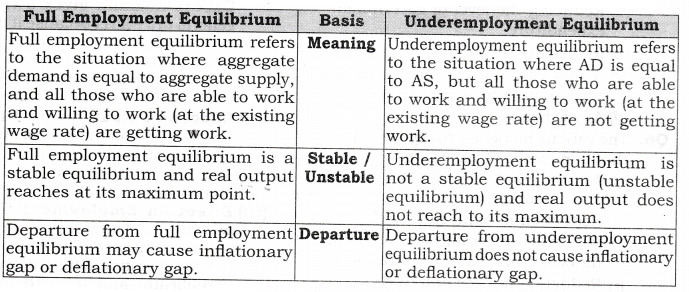
- Business and traders get credit from commercial bank against the security of their goods. Bank never gives credit equal to the full value of the security. It always pays less valuethan the security.
- So, the difference between the value of security and value of loan is called marginal requirement.
- In a situation of deficient demand leading to deflation, central bank decreases marginal requirements. This encourages borrowing because it makes people get more credit against their securities.
- Underemployment equilibrium refers to a situation when equilibrium is attained i.e., aggregate demand is equal to aggregate supply below full employment level or when resources are not fully employed.
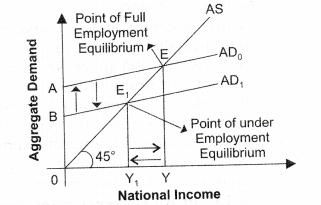
- In the above diagram full employment level of national income is attained at point E, but due to deficient demand, aggregate demand shifts downward from AD to AD0 and hew equilibrium is attained at point E1; which is below full employment level. The aggregate demand shifts downward because of the following reasons.(i) Decrease in household consumption demand due to fall in propensity to consume.(ii) Decrease in private investment demand because of fall in credit facilities.(iii) Decrease in public (government) expenditure.(iv) Decrease in export demand.(v) Decrease in money supply or decrease in disposable income.
- In order to achieve full employment equilibrium deficiency of demand must be corrected through additional investment expenditure. In the diagram deficiency of AD = AB. Thus, AB amount of additional investment is required to reach the level of full employment.
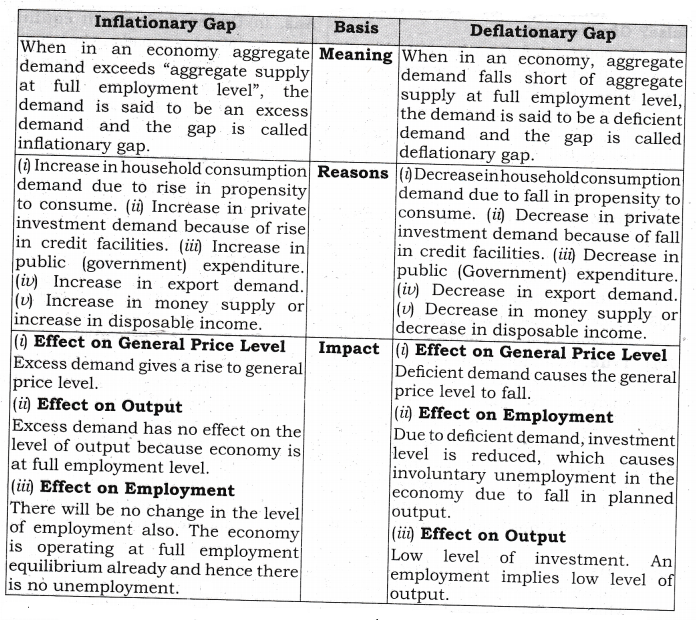
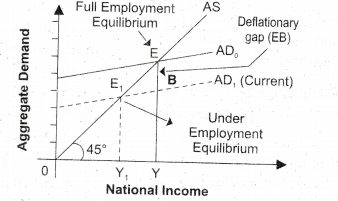
- Inflationary gap is the gap showing excess of current aggregate demand over ‘aggregate supply at the level of full employment’. It is called inflationary because it leads to inflation (continuous rise in prices).
- It can be explained with the help of following diagram:
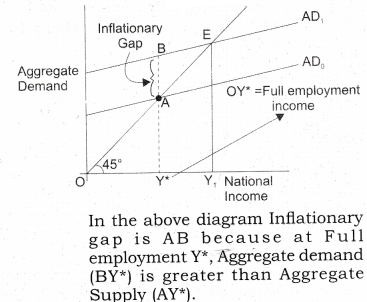
- (i) Repo rate is the. rate at which commercial bank borrow money from the central bank for short period by selling their financial securities to the central bank.(ii) These securities are pledged as a security for the loans.(iii) It is called Repurchase rate as this involves commercial bank selling securities to RBI to borrow the money with an agreement to repurchase them at a later date and at a predetermined price.(iv) So, keeping securities and borrowing is repo rate.(v) In a situation of excess demand leading to inflation,• Central bank raises repo rate that discourages commercial banks in borrowing from central bank as it will increase the cost of borrowing of commercial bank.• It forces the commercial banks to increase their lending rates, which discourages borrowers from taking loans, which discourages investment.• Again high rate of interest induces households to increase their savings by restricting expenditure on consumption.• Thus, expenditure on investment and consumption is reduced, which will control the excess demand.
- Deflationary gap is the gap showing deficient of current aggregate demand over ‘aggregate supply at the level of full employment. It is called deflationary because it leads to deflation (continuous fall in prices).
- It can be explained with the help of following diagram:
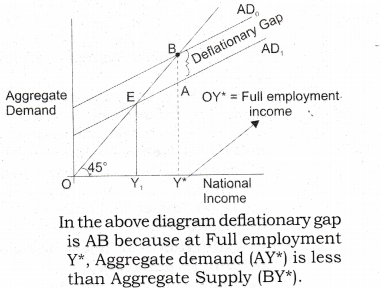
- (i) Open Market Operation consists of buying and selling of government securities and bonds in the open market by central bank.(ii) In a situation of deficient demand leading to deflation,central bank purchases government securities and bonds from commercial bank. With the purchase of these securities, the power of commercial bank of giving loans increases, which will control deficient demand.
- When in an economy, aggregate demand falls short of aggregate supply at full employment level, the demand is said to be a deficient demand.
- It can be explained with the help of following diagram:
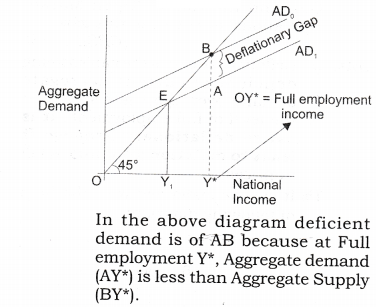
- (i) Bank rate is the rate of interest at which central bank lends to commercial banks without any collateral (security for purpose of loan). The thing, which has to be remembered, is that central bank lends to commercial banks and not to general public.(ii) In a situation of deficient demand leading to deflation,• Central bank decreases bank rate that encourages commercial banks in borrowing from central bank as it will decrease the cost of borrowing of commercial bank.• Decrease in bank rate makes commercial bank to decrease their lending rates, which encourages borrowers from taking loans, which encourages investment.• Again low rate of interest induces households to decrease their savings by increasing expenditure on consumption.• Thus, expenditure on investment and consumption increase, which will control the deficient demand.
- When in an economy, aggregate demand exceeds “aggregate supply at full employment level”, the demand is said to be an excess demand.
- It can be explained with the help of following diagram:
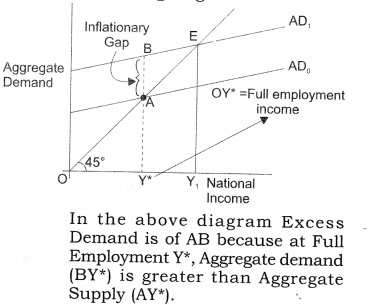
- (i) Reverse Repo Rate is the rate at which the central bank (RBI) borrows money from commercial bank.(ii) In a situation of excess demand leading to inflation, Reverse repo rate is increased, it encourages the commercial bank to park their funds with the central bank to earn higher return on idle cash. It decreases the lending capability of commercial banks, which controls excess demand.
- At full employment level.
- Over full employment level, or above the full employment level (in case of excess demand).
- Underemployment level or below full employment level (in case of deficient demand).
- At full employment equilibrium level: Full employment equilibrium refers to a situation when equilibrium is attained, i.e., aggregate demand is equal to aggregate supply at full employment level.In the given diagram, full employment level of national income and equilibrium level is attained at Point E. So, equilibrium is possible at full employment level.
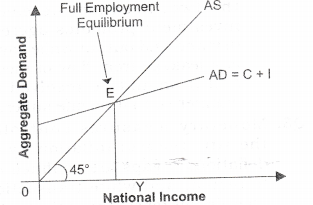
- Over full employment level or Above the full employment level: Over full employment level refers to a situation when equilibrium is attained, i.e., aggregate demand is equal to aggregate supply beyond full employment level.
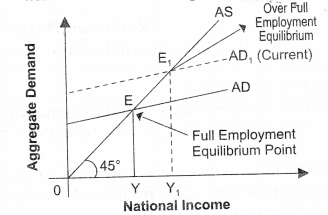 In the given diagram full employment level of national income is attained at point E, but due to the excess demand, the aggregate demand shifts upward from AD0 to AD0 Due to shift in AD the new equilibrium is attained at point E1 which is above the equilibrium level.
In the given diagram full employment level of national income is attained at point E, but due to the excess demand, the aggregate demand shifts upward from AD0 to AD0 Due to shift in AD the new equilibrium is attained at point E1 which is above the equilibrium level. - Underemployment equilibrium: It refers to a situation when equilibrium is attained, i.e., aggregate demand is equal to aggregate supply below the full employment level or when resources are not fully employed.
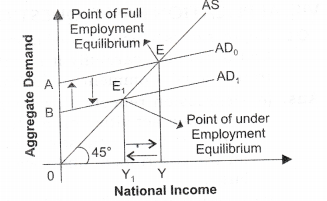 In the above diagram full employment level of national income is attained at point E but due to deficient demand, aggregate demand shifts downward from AD0 to AD1 and new equilibrium is attained at point Et, which is below full employment level.
In the above diagram full employment level of national income is attained at point E but due to deficient demand, aggregate demand shifts downward from AD0 to AD1 and new equilibrium is attained at point Et, which is below full employment level.
- Bank rate
- Cash reserve ratio (CRR)
- Statutory liquidity ratio (SLR)
Value : Critical thinking
- Increase in tax rates (Explain)
- Reduce public expenditure (Explain)
Value : Critical thinking
- Depression reflects slowdown of economic activities on all fronts and therefore is a cause of concern for the government and society at large.
- However, if tackled carefully taking appropriate monetary and fiscal measures, it may prove useful.
- As it has happened in 1929 in America, and also in the years from 2008 to 2012 in the context of slow down of the Indian economy.
- Households mobilize their savings and deposits it in the banks to earninterest for meeting their current and future needs.
- If there is a fall in the interest rate, they get less interest, and, hence, find it difficult to sustain their livelihood.
- But, on the other hand, RBI thinks of reducing interest rate for boosting the climate of investment.
- There is a contradiction between the two, because increase in investment promotes aggregate demand and output while savings is a leakage from flow of income, and it should be resolved in a manner so that no one suffers.
CBSE Economics For class 12



0 Comments
Please Comment